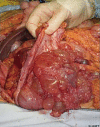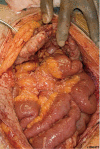Clinical presentation, diagnosis, classification and management of peritoneal mesothelioma: a review
- PMID: 29184697
- PMCID: PMC5674249
- DOI: 10.21037/jgo.2017.08.01
Clinical presentation, diagnosis, classification and management of peritoneal mesothelioma: a review
Abstract
Peritoneal mesothelioma (PM) is an uncommon but a serious, and often, fatal primary peritoneal tumour, with increasing incidence worldwide. Conventional systemic chemotherapy, generally based on experience with pleural mesothelioma, usually has disappointing results considering PM as a terminal condition. Patients usually present with non-specific symptoms of abdominal distension and pain making the diagnosis challenging. As PM is confined to the abdomen for all, or much, of its clinical course, a multimodality treatment combining cytoreductive surgery (CRS) with hyperthermic intraperitoneal chemotherapy (HIPEC) has emerged as a new standard of care, and has been reported to achieve promising survival outcomes and local disease control in selected patients with PM. This review updates the presentation, diagnosis, classification and treatment strategies for PM.
Keywords: Peritoneal mesothelioma (PM); cytoreductive surgery (CRS); hyperthermic intraperitoneal chemotherapy (HIPEC); peritoneal malignancy.
Conflict of interest statement
Conflicts of Interest: The authors have no conflicts of interest to declare.
Figures
References
Publication types
LinkOut - more resources
Full Text Sources
Other Literature Sources
Research Materials



